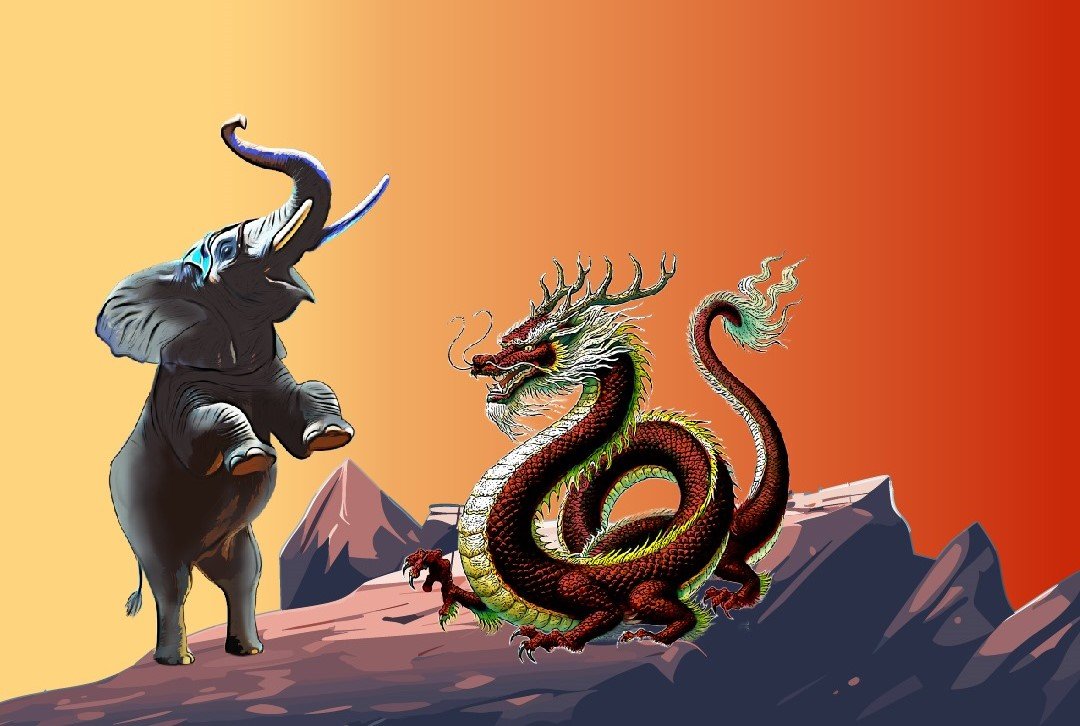Introduction
The bilateral relations between India and China, symbolically represented by the Elephant and the Dragon, are woven into the complexity of historical narratives, clash of cultures, national pride, and geopolitical rivalry. The psychological dimensions underlying these strained relations contribute to the persistent tensions and disruption in shaping the future course of their relationship.
Historical Narratives and National Identity
History has played a major role in shaping the national psyches of both countries. India’s narrative often highlights resistance against colonial rule and a proud democratic heritage, while China’s narrative focuses on overcoming the “Century of Humiliation” and restoring national pride with communism as the ideology. These differing historical outlooks result in a clash of global perspectives, and viewing each other through a lens of distrust and rivalry. The scars and outcome of the 1962 China-Indian War remain embedded in the national psyche of both countries. For India, the conflict dealt a significant blow to its national image, reshaping its defence policies and vigilance against the Chinese threat. For China, the conflict underscored its perceived superiority and hegemony. These historical memories continue to fuel mutual distrust only to be reinforced by China violating the peace treaties and tranquillity in the region.
Diplomatic practices in India and China reflect their unique cultural norms. Indian diplomacy is based on dialogue and democratic values, whereas Chinese diplomacy is more hierarchical, concealed and state-controlled. This divergent outlook often leads to misapprehensions and miscalculations. China views India’s contention on transparency as a breach of confidentiality, while India perceives China’s hegemonic approach as aggressive.
Clash of Strategic Cultures
-
- India’s Strategic Culture: India’s strategic culture is complex, yet composite, coherent and distinct. The teachings of mythological epics such as Ramayana and Mahabharata, values and education imbibed by ancient Hindu Vedic civilisations, statecraft with threads from Kautilya’s Arthashastra and braving over 2000 years of repeated invasions from the time of Alexander the Great in the year 321 BC to the British, only reinforced the idea of India. The secular threads and unity of the nation stood firm and deeply engrained, never severed or completely submerged by repeated challenges to its survival. This was due to an over 5000-year-old time-tested system based on “Dharma-Artha-Kama-Moksha”. The idea of India embraces the Upanishads’ worldview of “Vasudhaiva Kutumbakam”, a Sanskrit phrase meaning “the world is one family”. “Satyameva Jayate” (truth alone triumphs), a mantra from the ancient Indian scriptures, symbolised the deep cultural ethos and values. India was indeed a strong nation with a strong economy and a glorious culture with the power and the strength of knowledge and character. Unlike China, India’s strategic culture does not stipulate a bias for imperial expansionist aspirations, beyond those illegally occupied by the neighbourhood. It focuses instead on defending its geographical integrity against threats from land, sea, air, space, cyber, and information domains. This distinct approach emphasises maintaining sovereignty and unity. Thus India stands distinct from the conflicting revisionist ideology of China.
- China’s Strategic Culture: Chinese strategic culture and history has several distinctive characteristics and varied narratives. As a state it reflects inward-looking cloaked defensive behaviour, externally it professes the revisionist doctrine of foreign policy, militarily it focuses on power for strategic coercion, economically it creates resilience and global dependencies and strategically it aims at being the world’s superpower. Another deeply embedded manifestation is the “Middle Kingdom” mentality. Though it may be projected as defensive, it is intertwined with expansionist behaviour and incremental territorial expansion designs. The weight of the past shaping the strategic culture is also embedded in the narrative of the “Century of Humiliation” defined by defeat, unfair treaties, loss of territory and humiliations at the hands of Western powers before the People’s Republic of China was established in 1949. Chinese nationalism in its basic form encompasses the pride of being Chinese, the collective memory of the humiliations of the past, and the aspiration for a return to world supremacy. China’s aggressive behaviour thus reflects its ancient strategic culture deriving from complex and multiple historical narratives, affecting its foreign policy and outlook today. The political stronghold under Xi has only played up these cultural sentiments for the consolidation of power internally and revisionist designs externally through the tools of coercion.
Chinese nationalism encompasses the collective memory of the humiliation it suffered in the past, and the aspiration to become a superpower. China’s aggressive behaviour reflects its ancient strategic culture affecting its foreign policy and outlook today.
National Pride and Public Perception
-
- Media and Information Warfare: Media in both countries plays a pivotal role in shaping public perception and reinforcing nationalistic sentiments. Chinese state-controlled media misleadingly projects India, and its actions, as provocative. Conversely, India’s free but often sensationalist press emphasises Chinese aggression, fostering public anxiety and national pride. These media narratives exacerbate tensions by perpetuating adversarial views.
- Public Sentiment: Public sentiment, heavily influenced by historical narratives and media portrayals, exerts significant pressure on governmental policies. In democratic India, public opinion can sway electoral outcomes, compelling leaders to adopt firm stances against perceived Chinese threats. In China, while public sentiment is carefully managed by the state, it still plays a crucial role in shaping foreign policy decisions. National pride and the need to project strength often drive the leaders of both countries to take assertive positions.
Geopolitical Ambitions and Strategic Rivalry
-
- Territorial Disputes: The relationship between India and China is fraught with distrust and instability essentially due to Chinese hegemonic territorial design. The psychological aspect of these disputes is significant, as territory is closely linked to national pride and sovereignty. Each side’s unwillingness to compromise is driven by the fear of appearing weak, both domestically and internationally.
Chinese media misleadingly projects India, and its actions, as provocative whereas India’s media emphasises Chinese aggression, fostering public anxiety and national pride. These media narratives exacerbate tensions by perpetuating adversarial views.
-
- Economic and Military Rivalry: The competition for regional power status adds another layer to the psychological tension. Both India and China aspire to be the preeminent power in Asia. This rivalry extends to economic influence, military capabilities, and diplomatic clout. The desire to outdo each other can lead to an arms race and aggressive posturing, further straining relations.
Psychological Impact of Bilateral Deficit
-
- Trust Deficit: A major psychological barrier in the relationship is the trust deficit. This is due to China’s backstabbing and violation of peace treaties. Incidents such as Galwan and diplomatic spats deepen this mistrust making it difficult for both countries to engage in meaningful dialogue with positive outcomes.
- Leadership Psychology: The personal psychology of leaders also plays a crucial role. Strong leaders in both countries often adopt nationalistic and assertive policies to consolidate their domestic power. Their ambitions and perceptions of each other can influence bilateral relations significantly. A leader’s desire to leave a legacy or assert dominance can drive policies that heighten tensions.
The relationship between India and China is fraught with distrust and instability essentially due to Chinese hegemonic territorial designs. The psychological aspect of these disputes is significant, as territory is closely linked to national pride and sovereignty.
- Assertive Behaviour and Persistent Tensions: China’s strategic approach in the Himalayas and Indo-Pacific follows a four-point pattern: altering the status quo through military presence, employing coercive diplomacy, using legal rhetoric to legitimise actions, and leveraging state-controlled media for information warfare, all aimed at prolonging disputes and exhausting adversaries to enforce a new status quo. This leads to persistent tensions and rivalry.
Conclusion
The strained relations between India, the Elephant, and China, the Dragon, are deeply rooted in the psychological dynamics at play, including nationalism, public perception, trust deficit, and cultural mismatch, complicating the prospects for reconciliation. Any path to reconciliation requires both nations to address the psychological and cultural barriers that hinder progress to foster a mindset of mutual respect and address the trust deficit.
…
The author, a PVSM, AVSM, VSM has had an illustrious career spanning nearly four decades. A distinguished Armoured Corps officer, he has served in various prestigious staff and command appointments including Commander Independent Armoured Brigade, ADG PP, GOC Armoured Division and GOC Strike 1. The officer retired as DG Mechanised Forces in December 2017 during which he was the architect to initiate process for reintroduction of Light Tank and Chairman on the study on C5ISR for Indian Army. Subsequently he was Consultant MoD/OFB from 2018 to 2020. He is also a reputed defence analyst, a motivational speaker and prolific writer on matters of military, defence technology and national security. The views expressed are personal and do not necessarily carry the views of Raksha Anirveda
The author, a PVSM, AVSM, VSM has had an illustrious career spanning nearly four decades. A distinguished Armoured Corps officer, he has served in various prestigious staff and command appointments including Commander Independent Armoured Brigade, ADG PP, GOC Armoured Division and GOC Strike 1. The officer retired as DG Mechanised Forces in December 2017 during which he was the architect to initiate process for reintroduction of Light Tank and Chairman on the study on C5ISR for Indian Army. Subsequently he was Consultant MoD/OFB from 2018 to 2020. He is also a reputed defence analyst, a motivational speaker and prolific writer on matters of military, defence technology and national security. The views expressed are personal and do not necessarily carry the views of Raksha Anirveda






